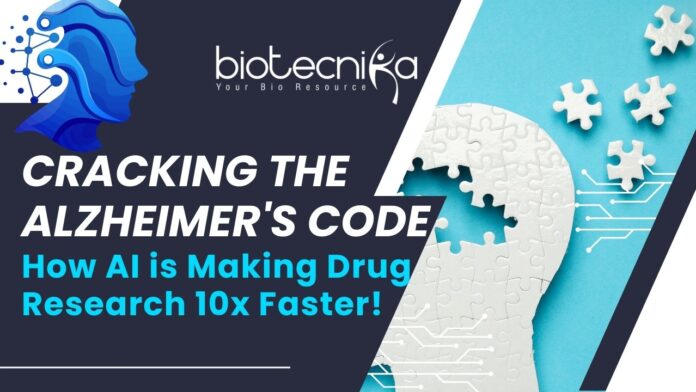Cracking the Alzheimer’s Code: How AI is Making Drug Research 10x Faster!
Alzheimer’s disease is one of the most challenging neurodegenerative diseases, affecting millions of people worldwide. Scientists are persistently striving to develop an effective treatment that can prevent the progression of the disease. Recently, scientists at the Oxford Drug Discovery Institute (ODDI) have unveiled a promising new approach to tackling this challenge.
Their secret weapon? Cutting-edge Artificial Intelligence. With the help of AI and its applications, researchers can find effective treatments that are revolutionizing the healthcare sector.
Decoding Alzheimer’s at Lightning Speed
Traditionally, combing through biomedical records, scientific literature, case files, and experimental data has been a painstaking and time-consuming activity. However, due to leveraging AI, there is a drastic change in the landscape; tasks that previously required weeks can now be accomplished in just a few days.
As per the ODDI, these sophisticated tools enable researchers to examine genetic and biomedical data almost tenfold quicker than in previous cases, helping them determine which genes or proteins should be focused on for drug development.
Emma Mead, Chief Scientific Officer at ODDI, states that the in stitute has selected 54 genes connected to Alzheimer’s. These genes have a role to play in the human immune system. They might be a crucial key to unlock new therapies. However, determining which ones represent the optimal drug targets is a complicated challenge—one that AI is remarkably effective at addressing.
Why is Finding Alzheimer’s Drug Targets So Challenging?
A single factor does not cause Alzheimer’s disease. It arises from an intricate web of multiple contributing elements like genetic predisposition, environmental factors, and socioeconomic conditions that make the research very complicated.
While scientists have identified hundreds of genes that may play a role in the disease, pinpointing the ones that genuinely drive its progression is the real challenge, it is like finding a needle in a haystack.
That’s where AI-powered knowledge graphs come in; the advent of AI-powered knowledge graphs marks a paradigm shift in how we approach the puzzle of Alzheimer’s drug discovery. These graphs work by connecting pieces of biomedical data—linking genes, proteins, diseases, and published research findings—into an interconnected matrix of knowledge, instead of researchers manually combing through thousands of studies and case files. AI can instantly highlight and pinpoint the most relevant connections, guiding scientists toward the most promising drug targets.
The Intelligent Future of Alzheimer’s Research
This pioneering methodology is not a standalone effort, but rather a vital part of a bigger picture, to seamlessly weave artificial intelligence with drug discovery.
By leveraging the unparalleled capabilities of AI to analyze an ocean of datasets and identify coherent data patterns beyond human capability, researchers have opened the door to new possibilities in medicine and healthcare.
Futuristic thinking AI-driven companies, such as Exscientia and Graphwise, are forming collaborations with esteemed institutions like Oxford Drug Discovery Institute (ODDI) to further polish these techniques. AI is already being used to develop drugs for conditions like cancer and autoimmune diseases, and its role in Alzheimer’s research is expected to grow significantly.
With over 55 million people worldwide living with dementia—a number projected to triple by 2050—the need for breakthroughs in Alzheimer’s treatment has never been more urgent.
For now, the scientists at Oxford are leading the charge, proving that AI isn’t just the future of medicine—it’s already transforming the present.
Cracking the Alzheimer’s Code: How AI is Making Drug Research 10x Faster!



























